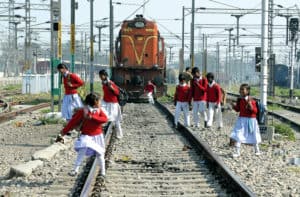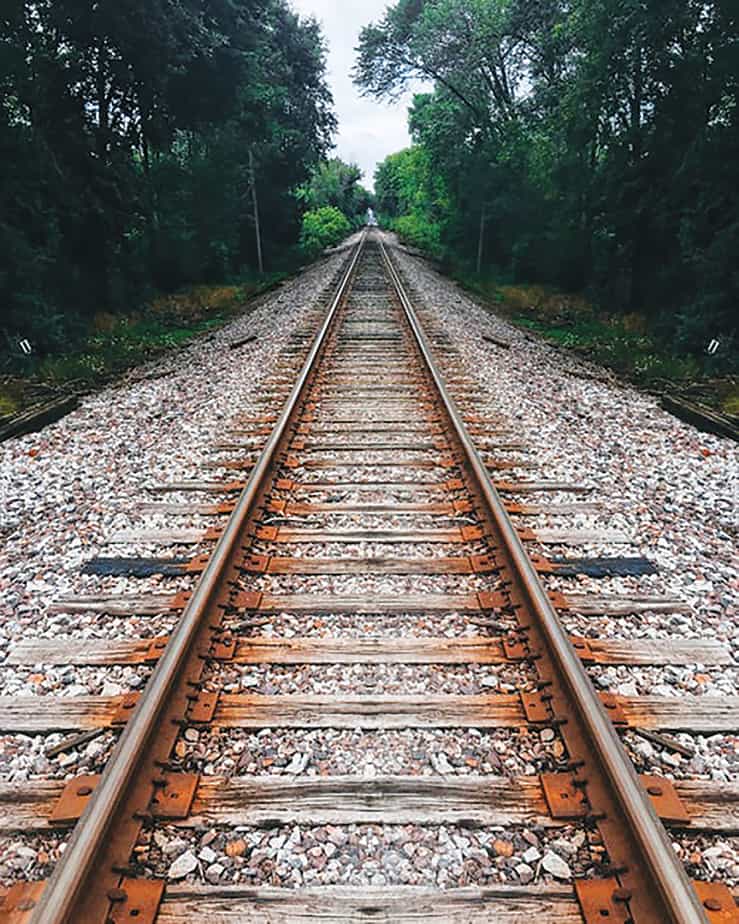People die mysteriously and live dangerously along the railway tracks, which are also a venue for festivals, drinking, dining, dating and even marriage
Under the Defence Colony flyover, a dirt road leads to the railway track. Nearby, for those who know the area well, is a tandoori chicken shop and an outlet for booze. People, even from relatively affluent families, come and engage with their love interest — also for other reasons — over a glass of beer.
“The feeling that you’re obscure, hidden and even unprotected, adds to the romance. There’s something sinister yet engaging about this place,” says a 28-year-old marketing executive who comes here frequently in the evenings accompanied by her boyfriend seven years her junior who studies in Dayal Singh College.
She’s not alone. People come, enjoy butter chicken, drink sitting along the railway track and make merry. And that leads to avoidable tragedies.
In Delhi alone, some 100 people die every year on railway tracks, including school children while crossing over to reach home. There have also been many cases of unwanted infant girls being thrown on the Railway tracks, to a certain, bloody end even before their lives begin.
Indian Railways is one of the biggest in the world with 1,15,000 km of track connecting more than a billion people of a country of sub-continental proportions. These railways tracks, especially close to urban conglomerates, become the mysterious underbelly, an amorphous zone, a labyrinth of the unknown.
In Delhi the problem areas are along the ring railways, particularly so from Cantonment to Patel Nagar and on the Kishenganj-Dayabasti-Shakurbasti route.
A sizeable part of homeless people live along the railway track in shanties and slums in Delhi. They celebrate festivals and host marriages, date, drink — and inevitably become victims of fatal accidents. This happens during all sorts of innocuous activities like trying to click a selfie from a stolen with a train charging along in the backdrop.
The eviction of jhuggis has become a costly affair ever since AAP government in Delhi raised the compensation amount from Rs 15,000 to Rs 15 lakh per family in 2016.
Meanwhile, the relatively desolate parts of the track are a breeding ground of criminal activities, a good hiding place, convenient site for committing suicide, a preferred location for executing murders and dumping of bodies. There’s so much happening along the tracks that doesn’t meet the eye of its millions of passengers.
The picture becomes sordid, unpalatable when a train mows down 59 people watching a Ravana effigy being burnt near Amritsar on October 19, everybody wondered in disgust: How could this be allowed to happen? This is not an isolated incident, but an example of living dangerously. As per the Railways data, 49,790 people were killed after being hit by speeding trains from 2015 to 2017.
They are all aware of the dangers, but in most cases it’s the shortest cut to the other side, as tracks bifurcate populated areas. People can be regularly seen crossing railway tracks to reach Okhla mandi from Friends Colony, risking their lives to buy cheap vegetables. The local railway authorities have, time and again, reported that it’s next to impossible to monitor such an extensive network to prevent jaywalking on the tracks, especially in the areas where there’s encroachment on the either side of the track.

The residents of posh localities like Defence Colony, Friends Colony and Nizamuddin, have registered complaints that railway tracks have become gambling dens and hideouts for criminals. For instance housewife Kamla Devi, resident of Veena Enclave, is witness to many deaths and is worried about her safety as the Railway Protection Force (RPF) personnel hardly see patrols in the area. “People feel unsafe as a lot of crime happens at night when people cross the tracks on their way home from work,” she said.
Not just Delhi, it’s a pan-India problem. In Mumbai ten days ago, Shashank Pandey, a young photographer was found dead on the railway tracks between Prabhadevi and Lower Parel. The cause of death is unknown. Railway police, however, are of the view that it’s an accidental fall from a local train. His body could only be identified a few days later after his 22-year-old wife lodged a missing complaint.
In another case in May this year, bodies of four brothers were recovered from railway tracks. The family alleged foul play, while the senior police inspector Shailendra Dhivar of Borivali GRP suspects that the brothers jumped off a moving train when another train coming from the opposite direction hit them. It’s a usual practice in Poisar area, and also in Delhi, when locals residing along the railway tracks jump of the train before it arrives at the platform.
Because of these unresolved cases — suicide, murder or accident — the RPF of the South Western Railway (SWR) from January 2017 to September 2018 prosecuted over 3,700 persons on charges of trespassing under Section 147 of the Railways Act, 1989, which entails punishment with imprisonment for a term up to six months, or a fine of Rs 1,000 or both.
“A nationwide campaign by Indian Railways has been launched against trespassing. Every effort is made to discourage rail users, general public from indulging in any practice detrimental to their individual safety, including trespassing of railway tracks,” a press note by the SWR states.
The Railways time and again caution people against indulging in any activity in the vicinity of railway tracks —even photography is prohibited. But their own workers are also in danger. The Western Railways decided to provide reflective vests to porters after two porters were knocked down by a local near Vasai on April 23.
No one is safe, not even the cops. A 28-year-old Delhi Police constable posted with Sarojini Nagar station was found dead near railway tracks in the Palam area, his toddler son sitting next to his body. The cause of death remains uncertain — as is life along the railway tracks.





